PROJ6000 Project Management: Project Selection Methods & Documents
VerifiedAdded on 2022/09/01
|9
|2207
|19
Report
AI Summary
This report provides an analysis of project selection methods applicable to organizations like SingularLogic, focusing on large-scale projects and the importance of choosing the best project based on investment and revenue. It examines methods such as cost-benefit analysis, Economic Value Added (EVA), payback period, and Net Present Value (NPV), detailing their application in project selection. The report also discusses the initiation process group, emphasizing project documentation, particularly the project charter, and stakeholder identification. It highlights the significance of project documentation in structuring critical thinking, keeping team members informed, and mitigating risks. The document also mentions the use of project selection methods as time tasted centered processes for selecting project.
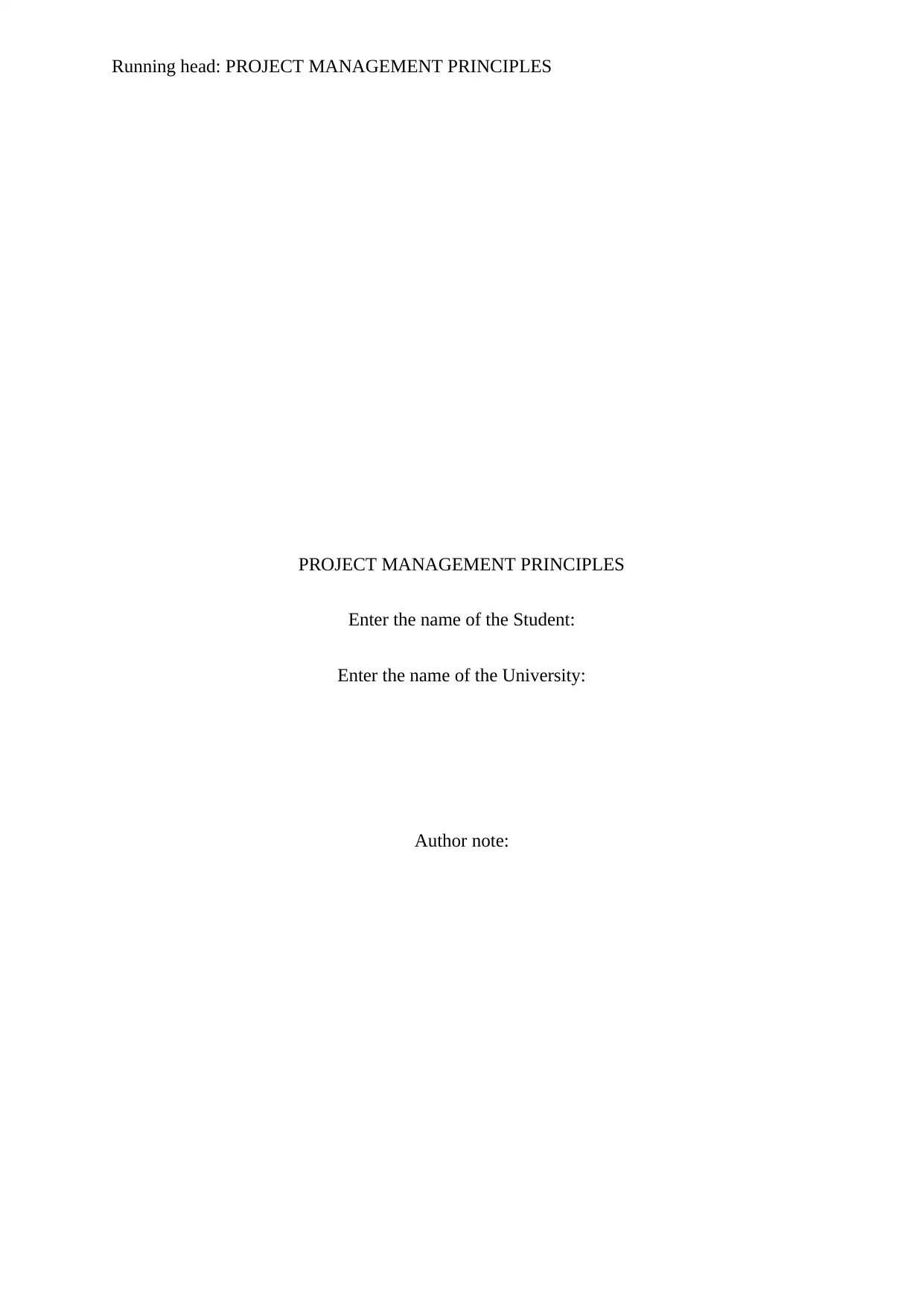
Running head: PROJECT MANAGEMENT PRINCIPLES
PROJECT MANAGEMENT PRINCIPLES
Enter the name of the Student:
Enter the name of the University:
Author note:
PROJECT MANAGEMENT PRINCIPLES
Enter the name of the Student:
Enter the name of the University:
Author note:
Paraphrase This Document
Need a fresh take? Get an instant paraphrase of this document with our AI Paraphraser
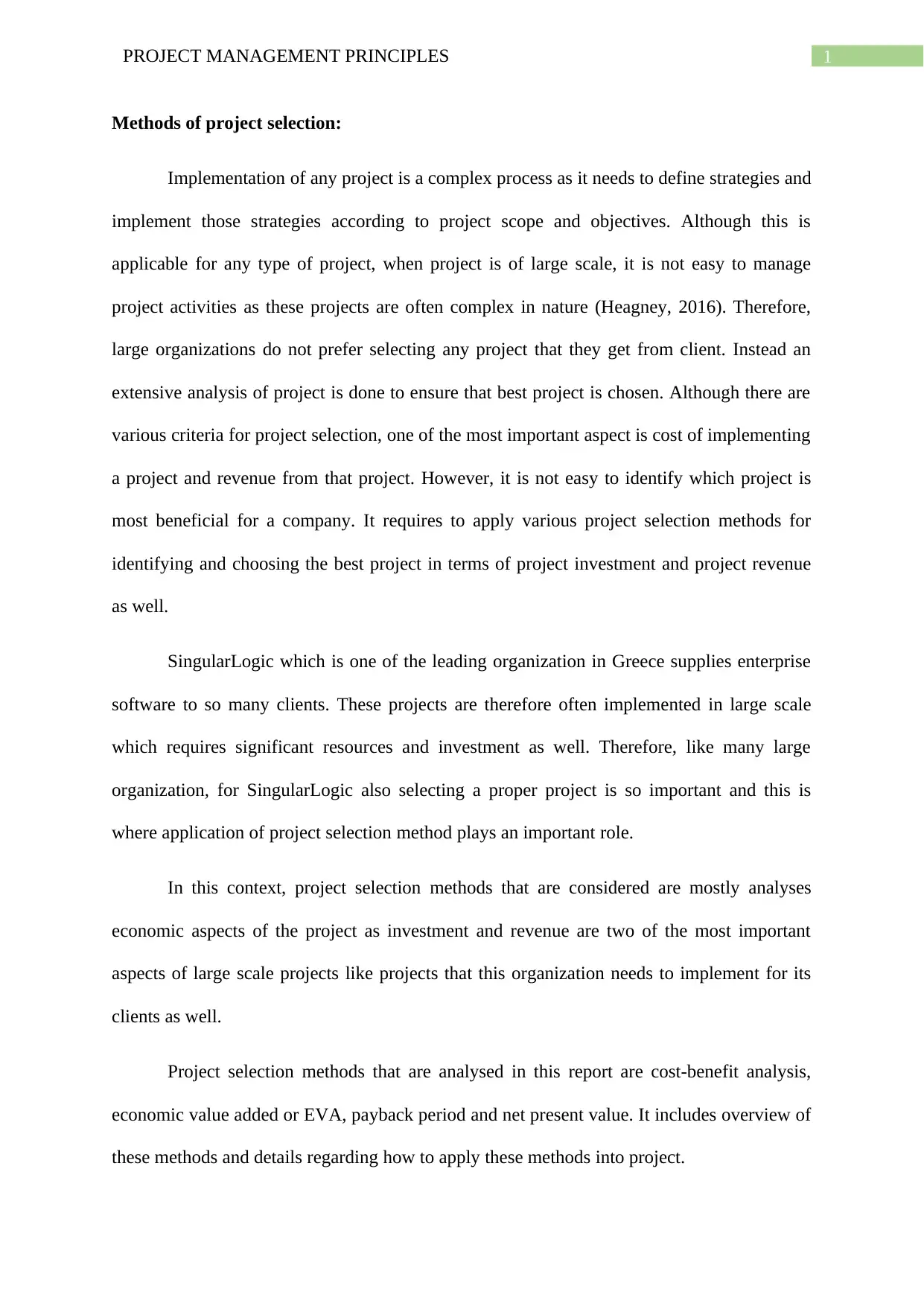
1PROJECT MANAGEMENT PRINCIPLES
Methods of project selection:
Implementation of any project is a complex process as it needs to define strategies and
implement those strategies according to project scope and objectives. Although this is
applicable for any type of project, when project is of large scale, it is not easy to manage
project activities as these projects are often complex in nature (Heagney, 2016). Therefore,
large organizations do not prefer selecting any project that they get from client. Instead an
extensive analysis of project is done to ensure that best project is chosen. Although there are
various criteria for project selection, one of the most important aspect is cost of implementing
a project and revenue from that project. However, it is not easy to identify which project is
most beneficial for a company. It requires to apply various project selection methods for
identifying and choosing the best project in terms of project investment and project revenue
as well.
SingularLogic which is one of the leading organization in Greece supplies enterprise
software to so many clients. These projects are therefore often implemented in large scale
which requires significant resources and investment as well. Therefore, like many large
organization, for SingularLogic also selecting a proper project is so important and this is
where application of project selection method plays an important role.
In this context, project selection methods that are considered are mostly analyses
economic aspects of the project as investment and revenue are two of the most important
aspects of large scale projects like projects that this organization needs to implement for its
clients as well.
Project selection methods that are analysed in this report are cost-benefit analysis,
economic value added or EVA, payback period and net present value. It includes overview of
these methods and details regarding how to apply these methods into project.
Methods of project selection:
Implementation of any project is a complex process as it needs to define strategies and
implement those strategies according to project scope and objectives. Although this is
applicable for any type of project, when project is of large scale, it is not easy to manage
project activities as these projects are often complex in nature (Heagney, 2016). Therefore,
large organizations do not prefer selecting any project that they get from client. Instead an
extensive analysis of project is done to ensure that best project is chosen. Although there are
various criteria for project selection, one of the most important aspect is cost of implementing
a project and revenue from that project. However, it is not easy to identify which project is
most beneficial for a company. It requires to apply various project selection methods for
identifying and choosing the best project in terms of project investment and project revenue
as well.
SingularLogic which is one of the leading organization in Greece supplies enterprise
software to so many clients. These projects are therefore often implemented in large scale
which requires significant resources and investment as well. Therefore, like many large
organization, for SingularLogic also selecting a proper project is so important and this is
where application of project selection method plays an important role.
In this context, project selection methods that are considered are mostly analyses
economic aspects of the project as investment and revenue are two of the most important
aspects of large scale projects like projects that this organization needs to implement for its
clients as well.
Project selection methods that are analysed in this report are cost-benefit analysis,
economic value added or EVA, payback period and net present value. It includes overview of
these methods and details regarding how to apply these methods into project.
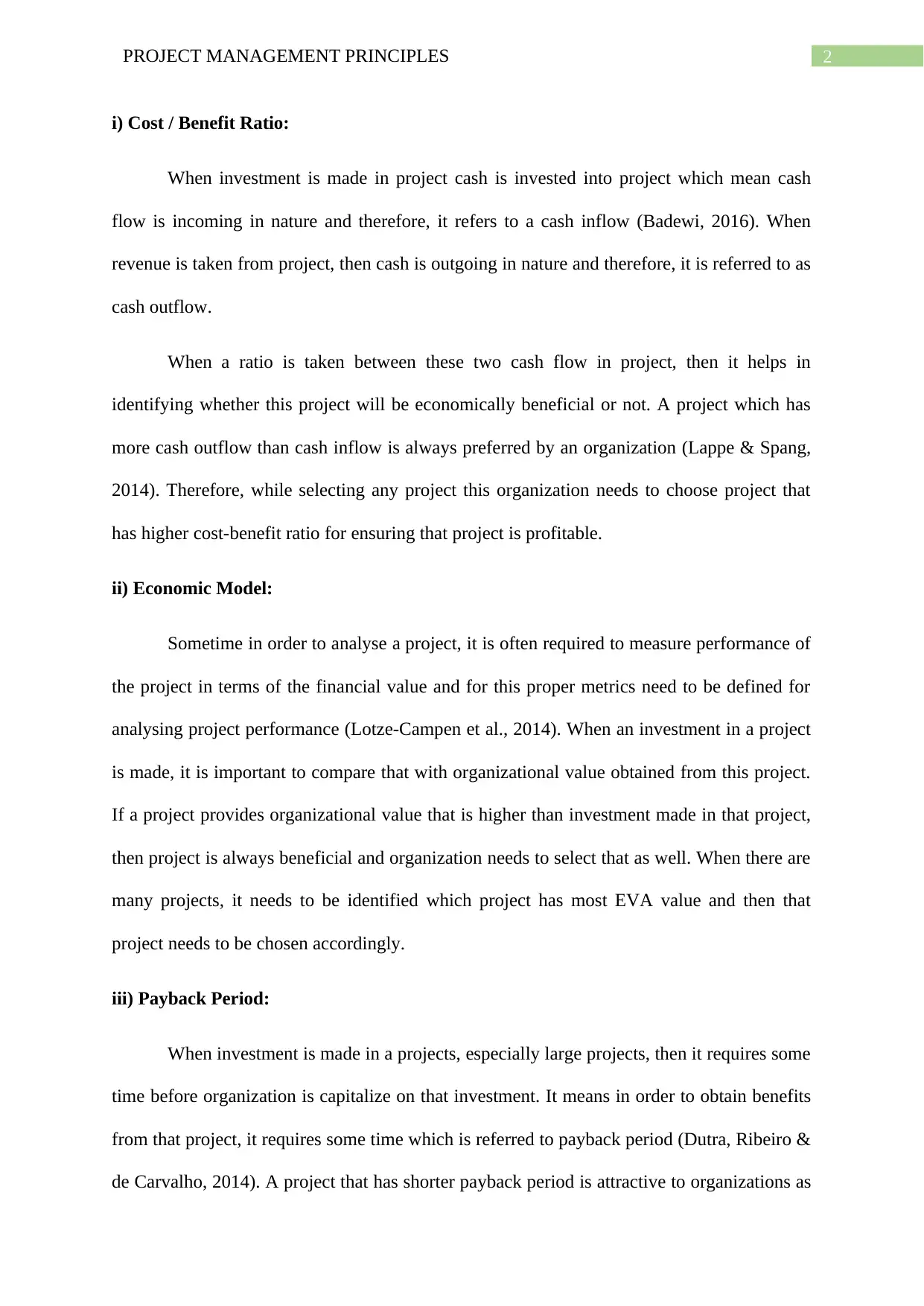
2PROJECT MANAGEMENT PRINCIPLES
i) Cost / Benefit Ratio:
When investment is made in project cash is invested into project which mean cash
flow is incoming in nature and therefore, it refers to a cash inflow (Badewi, 2016). When
revenue is taken from project, then cash is outgoing in nature and therefore, it is referred to as
cash outflow.
When a ratio is taken between these two cash flow in project, then it helps in
identifying whether this project will be economically beneficial or not. A project which has
more cash outflow than cash inflow is always preferred by an organization (Lappe & Spang,
2014). Therefore, while selecting any project this organization needs to choose project that
has higher cost-benefit ratio for ensuring that project is profitable.
ii) Economic Model:
Sometime in order to analyse a project, it is often required to measure performance of
the project in terms of the financial value and for this proper metrics need to be defined for
analysing project performance (Lotze‐Campen et al., 2014). When an investment in a project
is made, it is important to compare that with organizational value obtained from this project.
If a project provides organizational value that is higher than investment made in that project,
then project is always beneficial and organization needs to select that as well. When there are
many projects, it needs to be identified which project has most EVA value and then that
project needs to be chosen accordingly.
iii) Payback Period:
When investment is made in a projects, especially large projects, then it requires some
time before organization is capitalize on that investment. It means in order to obtain benefits
from that project, it requires some time which is referred to payback period (Dutra, Ribeiro &
de Carvalho, 2014). A project that has shorter payback period is attractive to organizations as
i) Cost / Benefit Ratio:
When investment is made in project cash is invested into project which mean cash
flow is incoming in nature and therefore, it refers to a cash inflow (Badewi, 2016). When
revenue is taken from project, then cash is outgoing in nature and therefore, it is referred to as
cash outflow.
When a ratio is taken between these two cash flow in project, then it helps in
identifying whether this project will be economically beneficial or not. A project which has
more cash outflow than cash inflow is always preferred by an organization (Lappe & Spang,
2014). Therefore, while selecting any project this organization needs to choose project that
has higher cost-benefit ratio for ensuring that project is profitable.
ii) Economic Model:
Sometime in order to analyse a project, it is often required to measure performance of
the project in terms of the financial value and for this proper metrics need to be defined for
analysing project performance (Lotze‐Campen et al., 2014). When an investment in a project
is made, it is important to compare that with organizational value obtained from this project.
If a project provides organizational value that is higher than investment made in that project,
then project is always beneficial and organization needs to select that as well. When there are
many projects, it needs to be identified which project has most EVA value and then that
project needs to be chosen accordingly.
iii) Payback Period:
When investment is made in a projects, especially large projects, then it requires some
time before organization is capitalize on that investment. It means in order to obtain benefits
from that project, it requires some time which is referred to payback period (Dutra, Ribeiro &
de Carvalho, 2014). A project that has shorter payback period is attractive to organizations as
⊘ This is a preview!⊘
Do you want full access?
Subscribe today to unlock all pages.

Trusted by 1+ million students worldwide
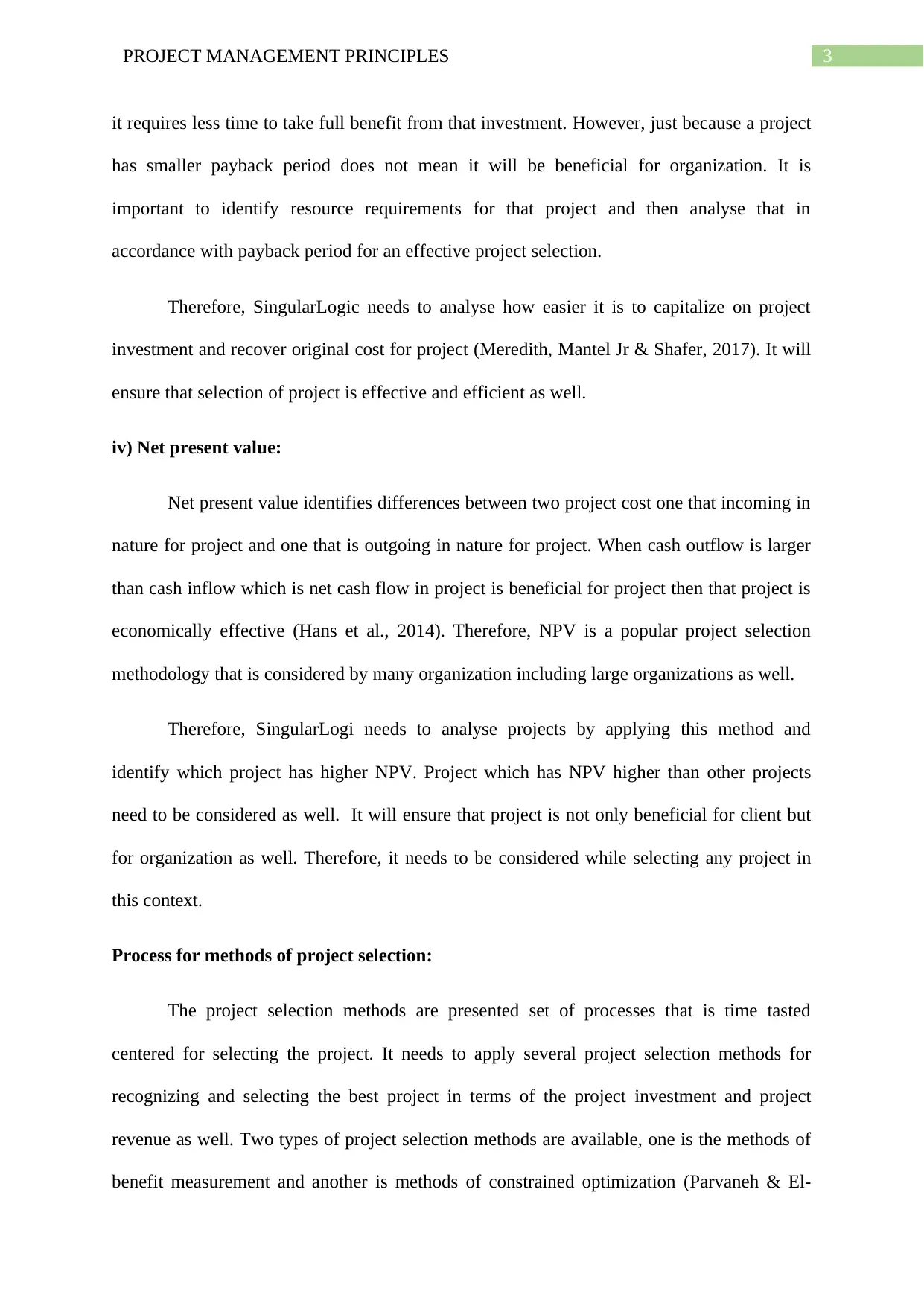
3PROJECT MANAGEMENT PRINCIPLES
it requires less time to take full benefit from that investment. However, just because a project
has smaller payback period does not mean it will be beneficial for organization. It is
important to identify resource requirements for that project and then analyse that in
accordance with payback period for an effective project selection.
Therefore, SingularLogic needs to analyse how easier it is to capitalize on project
investment and recover original cost for project (Meredith, Mantel Jr & Shafer, 2017). It will
ensure that selection of project is effective and efficient as well.
iv) Net present value:
Net present value identifies differences between two project cost one that incoming in
nature for project and one that is outgoing in nature for project. When cash outflow is larger
than cash inflow which is net cash flow in project is beneficial for project then that project is
economically effective (Hans et al., 2014). Therefore, NPV is a popular project selection
methodology that is considered by many organization including large organizations as well.
Therefore, SingularLogi needs to analyse projects by applying this method and
identify which project has higher NPV. Project which has NPV higher than other projects
need to be considered as well. It will ensure that project is not only beneficial for client but
for organization as well. Therefore, it needs to be considered while selecting any project in
this context.
Process for methods of project selection:
The project selection methods are presented set of processes that is time tasted
centered for selecting the project. It needs to apply several project selection methods for
recognizing and selecting the best project in terms of the project investment and project
revenue as well. Two types of project selection methods are available, one is the methods of
benefit measurement and another is methods of constrained optimization (Parvaneh & El-
it requires less time to take full benefit from that investment. However, just because a project
has smaller payback period does not mean it will be beneficial for organization. It is
important to identify resource requirements for that project and then analyse that in
accordance with payback period for an effective project selection.
Therefore, SingularLogic needs to analyse how easier it is to capitalize on project
investment and recover original cost for project (Meredith, Mantel Jr & Shafer, 2017). It will
ensure that selection of project is effective and efficient as well.
iv) Net present value:
Net present value identifies differences between two project cost one that incoming in
nature for project and one that is outgoing in nature for project. When cash outflow is larger
than cash inflow which is net cash flow in project is beneficial for project then that project is
economically effective (Hans et al., 2014). Therefore, NPV is a popular project selection
methodology that is considered by many organization including large organizations as well.
Therefore, SingularLogi needs to analyse projects by applying this method and
identify which project has higher NPV. Project which has NPV higher than other projects
need to be considered as well. It will ensure that project is not only beneficial for client but
for organization as well. Therefore, it needs to be considered while selecting any project in
this context.
Process for methods of project selection:
The project selection methods are presented set of processes that is time tasted
centered for selecting the project. It needs to apply several project selection methods for
recognizing and selecting the best project in terms of the project investment and project
revenue as well. Two types of project selection methods are available, one is the methods of
benefit measurement and another is methods of constrained optimization (Parvaneh & El-
Paraphrase This Document
Need a fresh take? Get an instant paraphrase of this document with our AI Paraphraser
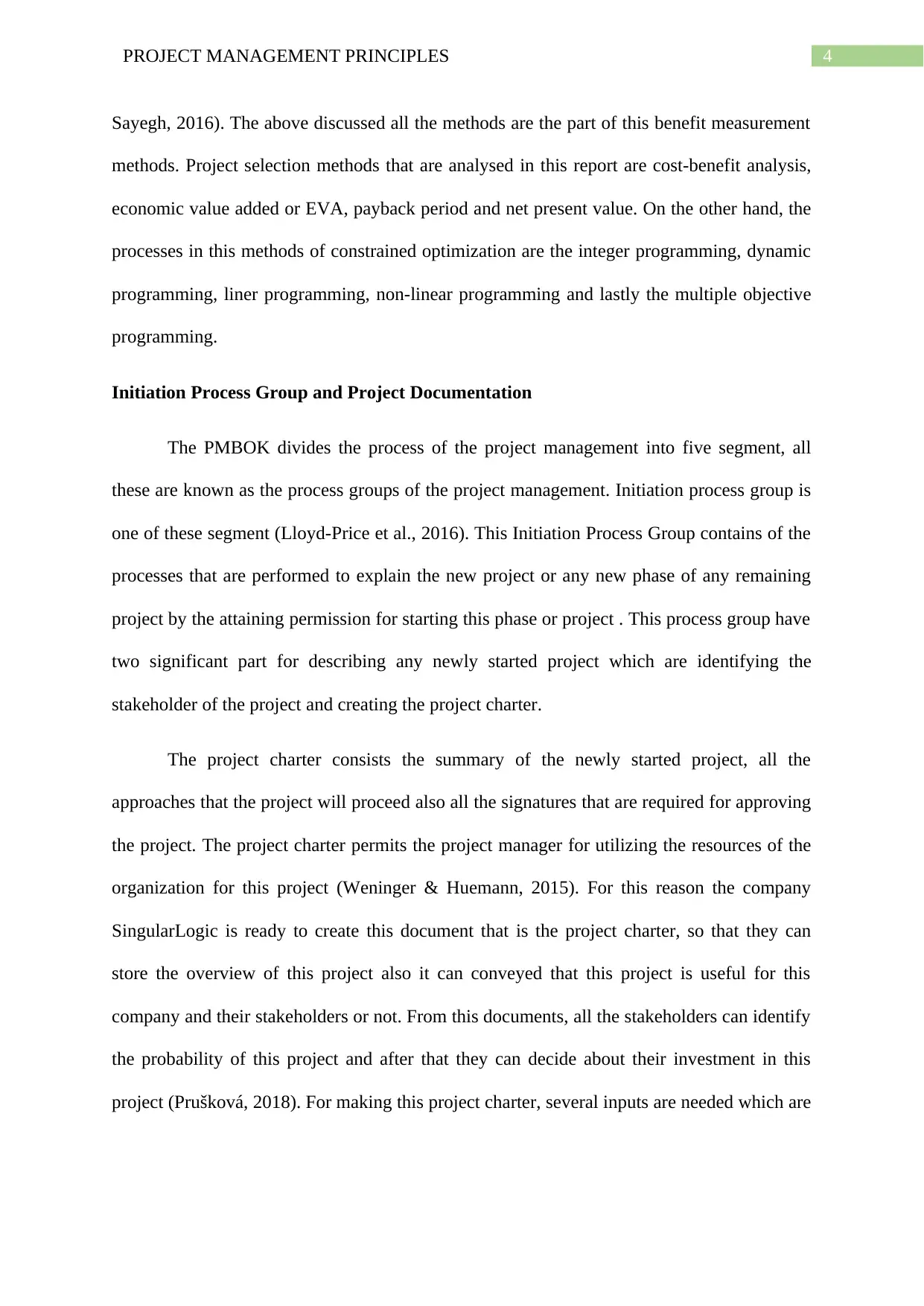
4PROJECT MANAGEMENT PRINCIPLES
Sayegh, 2016). The above discussed all the methods are the part of this benefit measurement
methods. Project selection methods that are analysed in this report are cost-benefit analysis,
economic value added or EVA, payback period and net present value. On the other hand, the
processes in this methods of constrained optimization are the integer programming, dynamic
programming, liner programming, non-linear programming and lastly the multiple objective
programming.
Initiation Process Group and Project Documentation
The PMBOK divides the process of the project management into five segment, all
these are known as the process groups of the project management. Initiation process group is
one of these segment (Lloyd-Price et al., 2016). This Initiation Process Group contains of the
processes that are performed to explain the new project or any new phase of any remaining
project by the attaining permission for starting this phase or project . This process group have
two significant part for describing any newly started project which are identifying the
stakeholder of the project and creating the project charter.
The project charter consists the summary of the newly started project, all the
approaches that the project will proceed also all the signatures that are required for approving
the project. The project charter permits the project manager for utilizing the resources of the
organization for this project (Weninger & Huemann, 2015). For this reason the company
SingularLogic is ready to create this document that is the project charter, so that they can
store the overview of this project also it can conveyed that this project is useful for this
company and their stakeholders or not. From this documents, all the stakeholders can identify
the probability of this project and after that they can decide about their investment in this
project (Prušková, 2018). For making this project charter, several inputs are needed which are
Sayegh, 2016). The above discussed all the methods are the part of this benefit measurement
methods. Project selection methods that are analysed in this report are cost-benefit analysis,
economic value added or EVA, payback period and net present value. On the other hand, the
processes in this methods of constrained optimization are the integer programming, dynamic
programming, liner programming, non-linear programming and lastly the multiple objective
programming.
Initiation Process Group and Project Documentation
The PMBOK divides the process of the project management into five segment, all
these are known as the process groups of the project management. Initiation process group is
one of these segment (Lloyd-Price et al., 2016). This Initiation Process Group contains of the
processes that are performed to explain the new project or any new phase of any remaining
project by the attaining permission for starting this phase or project . This process group have
two significant part for describing any newly started project which are identifying the
stakeholder of the project and creating the project charter.
The project charter consists the summary of the newly started project, all the
approaches that the project will proceed also all the signatures that are required for approving
the project. The project charter permits the project manager for utilizing the resources of the
organization for this project (Weninger & Huemann, 2015). For this reason the company
SingularLogic is ready to create this document that is the project charter, so that they can
store the overview of this project also it can conveyed that this project is useful for this
company and their stakeholders or not. From this documents, all the stakeholders can identify
the probability of this project and after that they can decide about their investment in this
project (Prušková, 2018). For making this project charter, several inputs are needed which are
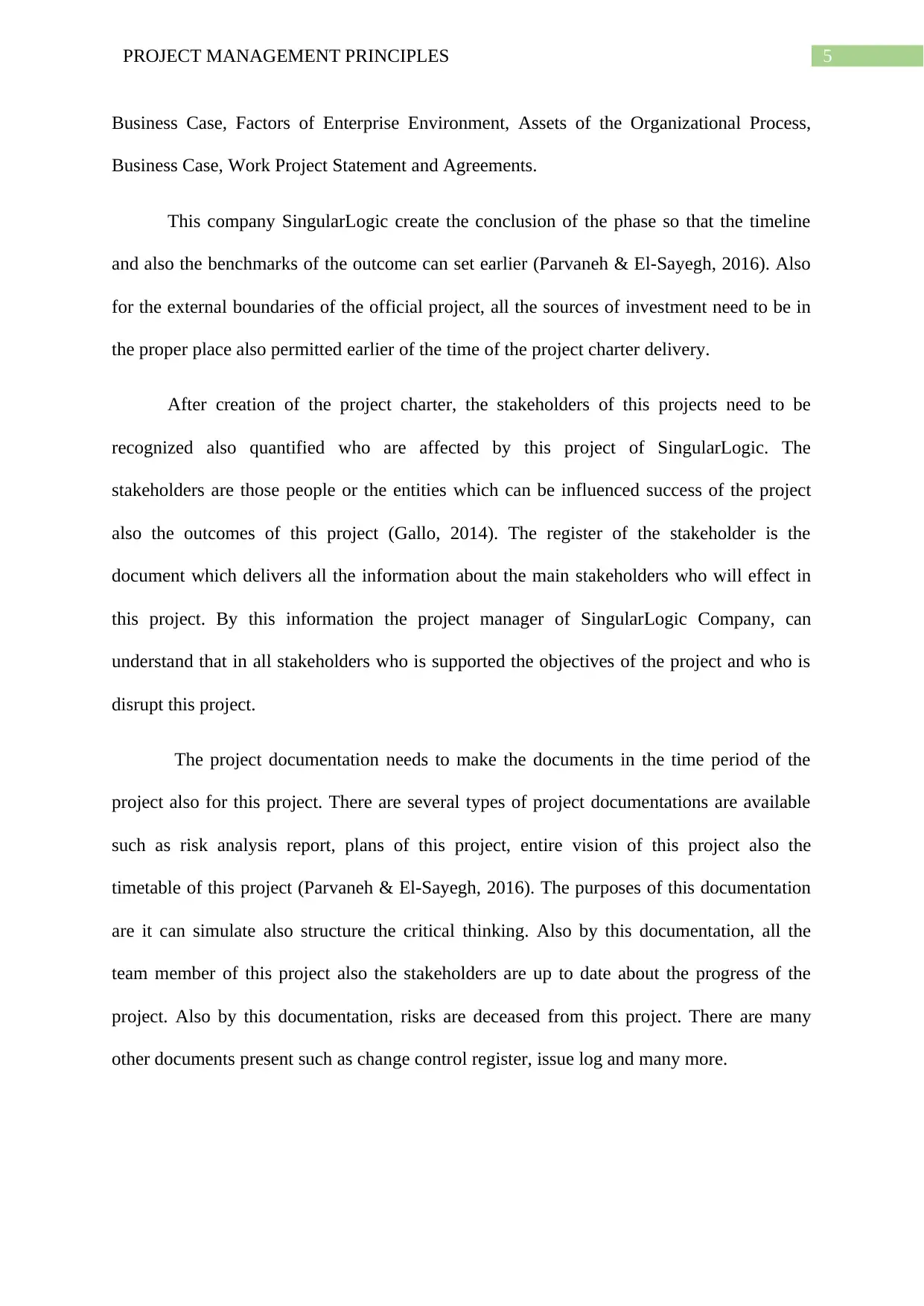
5PROJECT MANAGEMENT PRINCIPLES
Business Case, Factors of Enterprise Environment, Assets of the Organizational Process,
Business Case, Work Project Statement and Agreements.
This company SingularLogic create the conclusion of the phase so that the timeline
and also the benchmarks of the outcome can set earlier (Parvaneh & El-Sayegh, 2016). Also
for the external boundaries of the official project, all the sources of investment need to be in
the proper place also permitted earlier of the time of the project charter delivery.
After creation of the project charter, the stakeholders of this projects need to be
recognized also quantified who are affected by this project of SingularLogic. The
stakeholders are those people or the entities which can be influenced success of the project
also the outcomes of this project (Gallo, 2014). The register of the stakeholder is the
document which delivers all the information about the main stakeholders who will effect in
this project. By this information the project manager of SingularLogic Company, can
understand that in all stakeholders who is supported the objectives of the project and who is
disrupt this project.
The project documentation needs to make the documents in the time period of the
project also for this project. There are several types of project documentations are available
such as risk analysis report, plans of this project, entire vision of this project also the
timetable of this project (Parvaneh & El-Sayegh, 2016). The purposes of this documentation
are it can simulate also structure the critical thinking. Also by this documentation, all the
team member of this project also the stakeholders are up to date about the progress of the
project. Also by this documentation, risks are deceased from this project. There are many
other documents present such as change control register, issue log and many more.
Business Case, Factors of Enterprise Environment, Assets of the Organizational Process,
Business Case, Work Project Statement and Agreements.
This company SingularLogic create the conclusion of the phase so that the timeline
and also the benchmarks of the outcome can set earlier (Parvaneh & El-Sayegh, 2016). Also
for the external boundaries of the official project, all the sources of investment need to be in
the proper place also permitted earlier of the time of the project charter delivery.
After creation of the project charter, the stakeholders of this projects need to be
recognized also quantified who are affected by this project of SingularLogic. The
stakeholders are those people or the entities which can be influenced success of the project
also the outcomes of this project (Gallo, 2014). The register of the stakeholder is the
document which delivers all the information about the main stakeholders who will effect in
this project. By this information the project manager of SingularLogic Company, can
understand that in all stakeholders who is supported the objectives of the project and who is
disrupt this project.
The project documentation needs to make the documents in the time period of the
project also for this project. There are several types of project documentations are available
such as risk analysis report, plans of this project, entire vision of this project also the
timetable of this project (Parvaneh & El-Sayegh, 2016). The purposes of this documentation
are it can simulate also structure the critical thinking. Also by this documentation, all the
team member of this project also the stakeholders are up to date about the progress of the
project. Also by this documentation, risks are deceased from this project. There are many
other documents present such as change control register, issue log and many more.
⊘ This is a preview!⊘
Do you want full access?
Subscribe today to unlock all pages.

Trusted by 1+ million students worldwide

6PROJECT MANAGEMENT PRINCIPLES
Paraphrase This Document
Need a fresh take? Get an instant paraphrase of this document with our AI Paraphraser
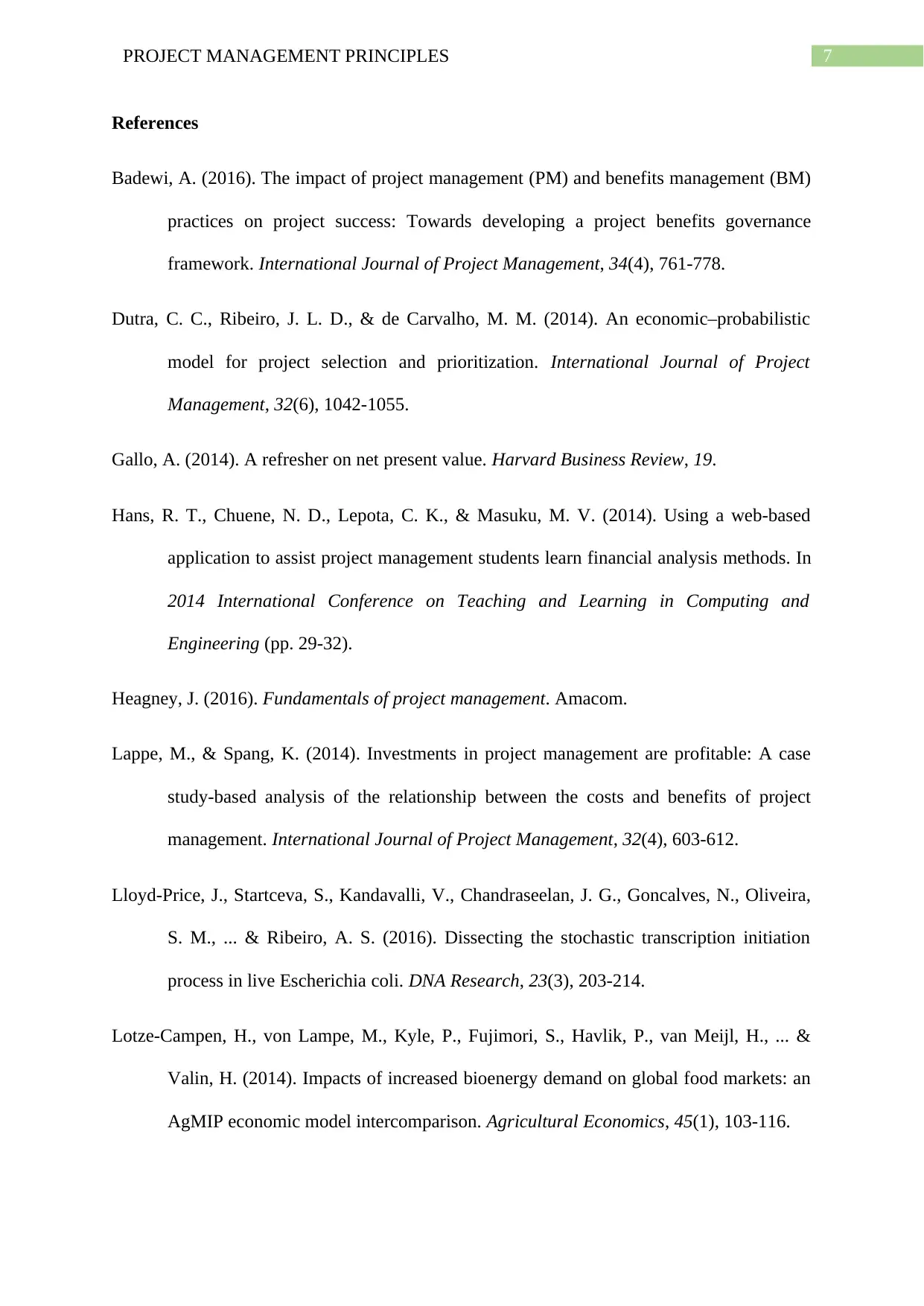
7PROJECT MANAGEMENT PRINCIPLES
References
Badewi, A. (2016). The impact of project management (PM) and benefits management (BM)
practices on project success: Towards developing a project benefits governance
framework. International Journal of Project Management, 34(4), 761-778.
Dutra, C. C., Ribeiro, J. L. D., & de Carvalho, M. M. (2014). An economic–probabilistic
model for project selection and prioritization. International Journal of Project
Management, 32(6), 1042-1055.
Gallo, A. (2014). A refresher on net present value. Harvard Business Review, 19.
Hans, R. T., Chuene, N. D., Lepota, C. K., & Masuku, M. V. (2014). Using a web-based
application to assist project management students learn financial analysis methods. In
2014 International Conference on Teaching and Learning in Computing and
Engineering (pp. 29-32).
Heagney, J. (2016). Fundamentals of project management. Amacom.
Lappe, M., & Spang, K. (2014). Investments in project management are profitable: A case
study-based analysis of the relationship between the costs and benefits of project
management. International Journal of Project Management, 32(4), 603-612.
Lloyd-Price, J., Startceva, S., Kandavalli, V., Chandraseelan, J. G., Goncalves, N., Oliveira,
S. M., ... & Ribeiro, A. S. (2016). Dissecting the stochastic transcription initiation
process in live Escherichia coli. DNA Research, 23(3), 203-214.
Lotze‐Campen, H., von Lampe, M., Kyle, P., Fujimori, S., Havlik, P., van Meijl, H., ... &
Valin, H. (2014). Impacts of increased bioenergy demand on global food markets: an
AgMIP economic model intercomparison. Agricultural Economics, 45(1), 103-116.
References
Badewi, A. (2016). The impact of project management (PM) and benefits management (BM)
practices on project success: Towards developing a project benefits governance
framework. International Journal of Project Management, 34(4), 761-778.
Dutra, C. C., Ribeiro, J. L. D., & de Carvalho, M. M. (2014). An economic–probabilistic
model for project selection and prioritization. International Journal of Project
Management, 32(6), 1042-1055.
Gallo, A. (2014). A refresher on net present value. Harvard Business Review, 19.
Hans, R. T., Chuene, N. D., Lepota, C. K., & Masuku, M. V. (2014). Using a web-based
application to assist project management students learn financial analysis methods. In
2014 International Conference on Teaching and Learning in Computing and
Engineering (pp. 29-32).
Heagney, J. (2016). Fundamentals of project management. Amacom.
Lappe, M., & Spang, K. (2014). Investments in project management are profitable: A case
study-based analysis of the relationship between the costs and benefits of project
management. International Journal of Project Management, 32(4), 603-612.
Lloyd-Price, J., Startceva, S., Kandavalli, V., Chandraseelan, J. G., Goncalves, N., Oliveira,
S. M., ... & Ribeiro, A. S. (2016). Dissecting the stochastic transcription initiation
process in live Escherichia coli. DNA Research, 23(3), 203-214.
Lotze‐Campen, H., von Lampe, M., Kyle, P., Fujimori, S., Havlik, P., van Meijl, H., ... &
Valin, H. (2014). Impacts of increased bioenergy demand on global food markets: an
AgMIP economic model intercomparison. Agricultural Economics, 45(1), 103-116.
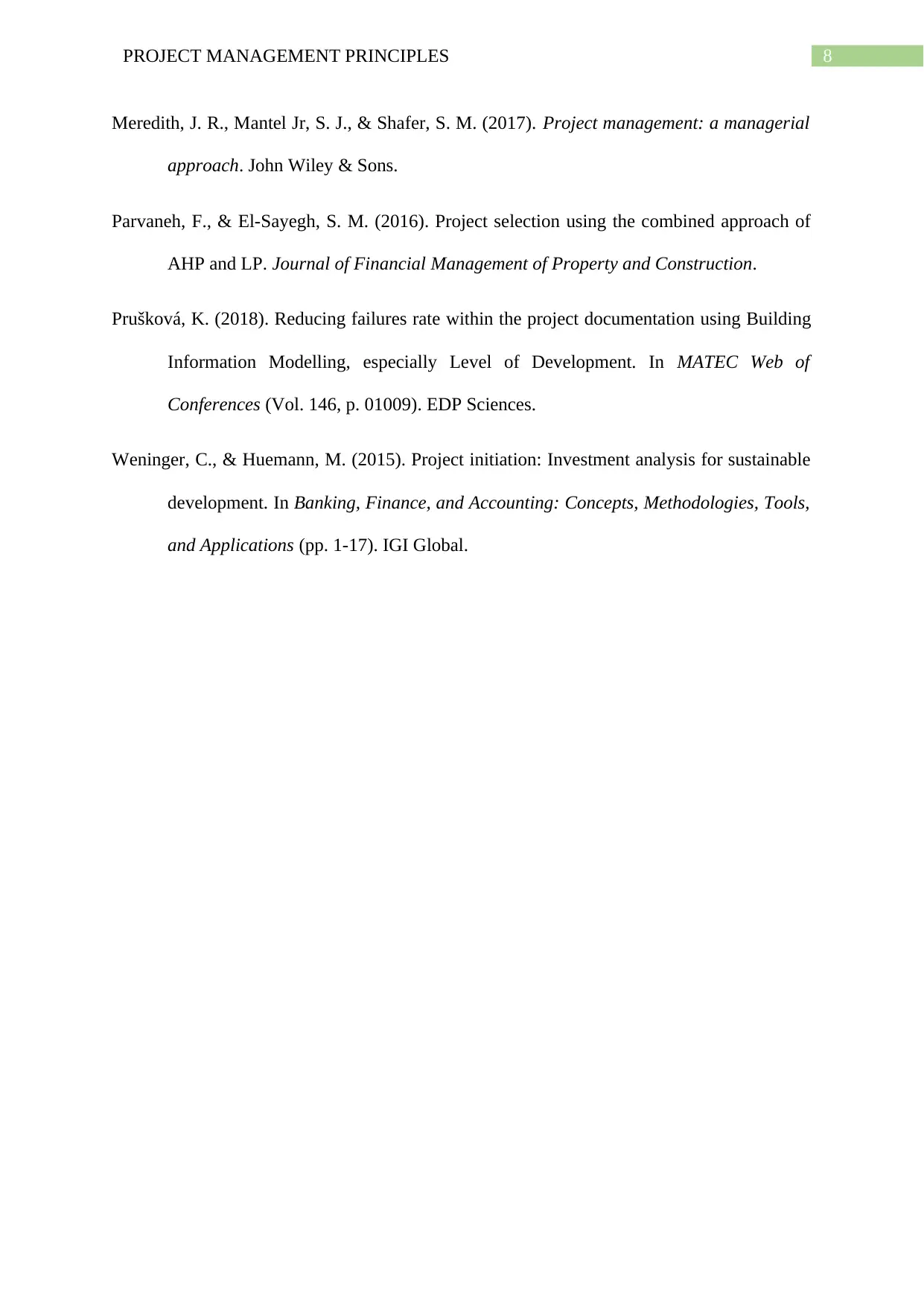
8PROJECT MANAGEMENT PRINCIPLES
Meredith, J. R., Mantel Jr, S. J., & Shafer, S. M. (2017). Project management: a managerial
approach. John Wiley & Sons.
Parvaneh, F., & El-Sayegh, S. M. (2016). Project selection using the combined approach of
AHP and LP. Journal of Financial Management of Property and Construction.
Prušková, K. (2018). Reducing failures rate within the project documentation using Building
Information Modelling, especially Level of Development. In MATEC Web of
Conferences (Vol. 146, p. 01009). EDP Sciences.
Weninger, C., & Huemann, M. (2015). Project initiation: Investment analysis for sustainable
development. In Banking, Finance, and Accounting: Concepts, Methodologies, Tools,
and Applications (pp. 1-17). IGI Global.
Meredith, J. R., Mantel Jr, S. J., & Shafer, S. M. (2017). Project management: a managerial
approach. John Wiley & Sons.
Parvaneh, F., & El-Sayegh, S. M. (2016). Project selection using the combined approach of
AHP and LP. Journal of Financial Management of Property and Construction.
Prušková, K. (2018). Reducing failures rate within the project documentation using Building
Information Modelling, especially Level of Development. In MATEC Web of
Conferences (Vol. 146, p. 01009). EDP Sciences.
Weninger, C., & Huemann, M. (2015). Project initiation: Investment analysis for sustainable
development. In Banking, Finance, and Accounting: Concepts, Methodologies, Tools,
and Applications (pp. 1-17). IGI Global.
⊘ This is a preview!⊘
Do you want full access?
Subscribe today to unlock all pages.

Trusted by 1+ million students worldwide
1 out of 9
Related Documents
Your All-in-One AI-Powered Toolkit for Academic Success.
+13062052269
info@desklib.com
Available 24*7 on WhatsApp / Email
![[object Object]](/_next/static/media/star-bottom.7253800d.svg)
Unlock your academic potential
Copyright © 2020–2025 A2Z Services. All Rights Reserved. Developed and managed by ZUCOL.




